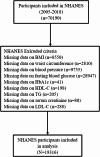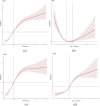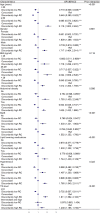Association between remnant cholesterol and low-density lipoprotein cholesterol discordance and type 2 diabetes or prediabetes: results from NHANES
- PMID: 40624651
- PMCID: PMC12232856
- DOI: 10.1186/s12902-025-01995-0
Association between remnant cholesterol and low-density lipoprotein cholesterol discordance and type 2 diabetes or prediabetes: results from NHANES
Abstract
Objective: There is limited evidence on the relationship between remnant cholesterol (RC) and low-density lipoprotein cholesterol (LDL-C) discordance and type 2 diabetes or prediabetes. This study aimed to investigate the association between RC and LDL-C discordance and type 2 diabetes or prediabetes in the general US adult population.
Methods: Data from 19,604 participants in the National Health and Nutrition Examination Surveys (NHANES) (2005-2018) were analyzed. The percentile difference between RC and LDL-C was used to define discordance. Logistic regression models were performed to assess the relationships between RC, LDL-C, RC and LDL-C percentile difference, LDL-C and RC discordant. Nonlinear relationships were explored using restricted cubic splines. Mediation analysis was conducted to evaluate the direct and indirect relationships between abdominal obesity and type 2 diabetes through RC.
Results: RC was non-linearly and J-shaped correlated with type 2 diabetes and prediabetes, whereas LDL-C was non-linearly and U-shaped correlated with type 2 diabetes and was S-shaped correlated with prediabetes. Compared to concordant participants, those with discordantly low RC population had lower type 2 diabetes odds, while those with the discordantly high RC population had higher type 2 diabetes and prediabetes odds. When a clinical LDL-C cut-off of 2.60 mmol/L was applied, participants in the high LDL-C and low RC group had the lowest odds of type 2 diabetes, while those in the low LDL-C and high RC group had the highest odds. Significant interactions between LDL-C and RC discordance and factors such as age, MetS, and lipid-lowering medications were observed in relation to type 2 diabetes odds. RC was found to mediate 15.86% of the association between abdominal obesity and type 2 diabetes, and 16.22% of the association between abdominal obesity and prediabetes in the non-diabetes population.
Conclusions: Discordantly high RC was associated with higher odds of type 2 diabetes and prediabetes, while discordantly low RC was associated with lower odds of type 2 diabetes.
Keywords: Low-density lipoprotein cholesterol; Prediabetes; Remnant cholesterol; Remnant cholesterol and low-density lipoprotein cholesterol discordance; Type 2 diabetes.
© 2025. The Author(s).
Conflict of interest statement
Declarations. Ethics approval and consent to participate: The NHANES study protocol was approved by the NCHS Research Ethics Review Board, and written informed consent was provided by all participants. Competing interests: The authors declare no competing interests. Consent to publication: Not applicable. Clinical trial number: Not applicable.
Figures




Similar articles
-
A cross-sectional analysis of remnant cholesterol-diabetes association in US adults.Sci Rep. 2025 Jul 22;15(1):26572. doi: 10.1038/s41598-025-10961-8. Sci Rep. 2025. PMID: 40695895 Free PMC article.
-
Unveiling the UHR threshold in American adult: a new biomarker for early diabetes detection from NHANES study.BMC Endocr Disord. 2025 Aug 15;25(1):195. doi: 10.1186/s12902-025-02012-0. BMC Endocr Disord. 2025. PMID: 40814104 Free PMC article.
-
Association of remnant cholesterol with progression and regression of prediabetes in middle-aged and older adults: a nationwide cohort study.Acta Diabetol. 2025 Jul;62(7):1023-1030. doi: 10.1007/s00592-024-02416-9. Epub 2024 Nov 20. Acta Diabetol. 2025. PMID: 39565373
-
Discordance between serum cholesterol concentration and atherogenic lipoprotein particle number in people with metabolic disease: A systematic review.Diabetes Obes Metab. 2025 Jun;27(6):2940-2954. doi: 10.1111/dom.16335. Epub 2025 Mar 16. Diabetes Obes Metab. 2025. PMID: 40091449
-
Quality improvement strategies for diabetes care: Effects on outcomes for adults living with diabetes.Cochrane Database Syst Rev. 2023 May 31;5(5):CD014513. doi: 10.1002/14651858.CD014513. Cochrane Database Syst Rev. 2023. PMID: 37254718 Free PMC article.
References
-
- Athyros VG, Doumas M, Imprialos KP, et al. Diabetes and lipid metabolism. Horm (Athens). 2018;17(1):61–7. 10.1007/s42000-018-0014-8. - PubMed
MeSH terms
Substances
Grants and funding
LinkOut - more resources
Full Text Sources
Medical

